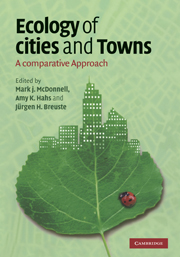Book contents
- Frontmatter
- Contents
- List of contributors
- Preface
- 1 Introduction: Scope of the book and need for developing a comparative approach to the ecological study of cities and towns
- Part I Opportunities and challenges of conducting comparative studies
- 2 Comparative urban ecology: challenges and possibilities
- 3 Frameworks for urban ecosystem studies: gradients, patch dynamics and the human ecosystem in the New York metropolitan area and Baltimore, USA
- 4 Comparative effects of urbanisation in marine and terrestrial habitats
- 5 Comparative ecology of cities and towns: past, present and future
- 6 Comparative urban ecological research in developing countries
- 7 Using models to compare the ecology of cities
- Part II Ecological studies of cities and towns
- Part III Integrating science with management and planning
- Part IV Comments and synthesis
- References
- Index
- Plate section
4 - Comparative effects of urbanisation in marine and terrestrial habitats
Published online by Cambridge University Press: 04 March 2010
- Frontmatter
- Contents
- List of contributors
- Preface
- 1 Introduction: Scope of the book and need for developing a comparative approach to the ecological study of cities and towns
- Part I Opportunities and challenges of conducting comparative studies
- 2 Comparative urban ecology: challenges and possibilities
- 3 Frameworks for urban ecosystem studies: gradients, patch dynamics and the human ecosystem in the New York metropolitan area and Baltimore, USA
- 4 Comparative effects of urbanisation in marine and terrestrial habitats
- 5 Comparative ecology of cities and towns: past, present and future
- 6 Comparative urban ecological research in developing countries
- 7 Using models to compare the ecology of cities
- Part II Ecological studies of cities and towns
- Part III Integrating science with management and planning
- Part IV Comments and synthesis
- References
- Index
- Plate section
Summary
Introduction
Urbanisation and agriculture are likely to be the most extensive environmental impacts that humans impose on the natural world. In 1997, it was estimated that across developed and undeveloped countries, 50% of people would live in urbanised environments by 2000, with 400 million of them in only 25 cities (Botkin and Beveridge,1997). These are not particularly new figures and are probably already out of date, but there is no doubt that the trend worldwide is for people to crowd into smaller and smaller areas as populations grow. The density of people in urbanised environments is very large (in excess of 2000 people/km2) and, because of limits to the heights of buildings, cultural imperatives for home ownership and so on, urban centres are spreading rapidly.
What is less often thought about is where the large cities are. An aerial view of the planet at night clearly shows the lights of the large urbanised centres. Apart from those in the eastern part of the USA and western Europe, these lights clearly outline the coasts and large river systems of the continents (Earth's city lights, courtesy NASA; http://earthobservatory.nasa.gov). Most large and small cities, especially those that developed prior to extensive road and rail transport, are on the coast or along waterways because of reliance on water for transport and travel. Eleven of the 15 largest cities in the world are coastal.
- Type
- Chapter
- Information
- Ecology of Cities and TownsA Comparative Approach, pp. 51 - 70Publisher: Cambridge University PressPrint publication year: 2009
- 4
- Cited by

